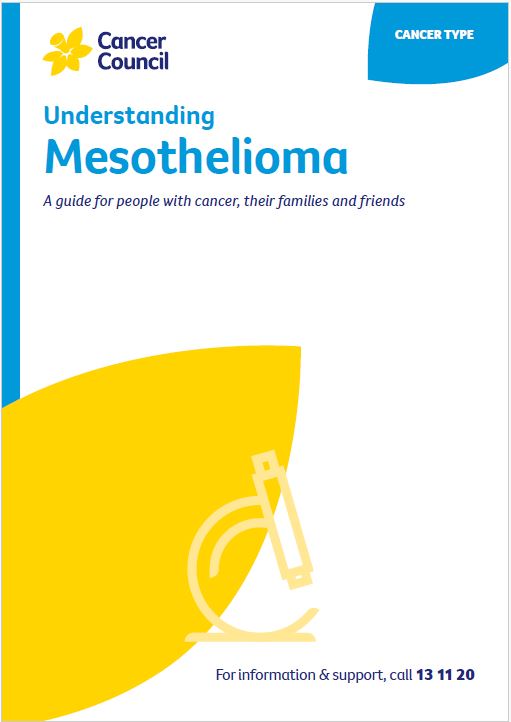- Home
- Peritoneal mesothelioma
- Managing symptoms
- Breathlessness
Breathlessness
Shortness of breath, also called breathlessness, is a common symptom of peritoneal mesothelioma. Read on to learn how to manage this.
Learn more about:
Overview
In peritoneal mesothelioma, a build-up of fluid (ascites) can cause the abdomen to swell. This can be painful, but also puts pressure on the diaphragm and can make you feel breathless.
Other problems such as infection or a low level of red blood cells (anaemia) can also cause breathlessness. Living with breathlessness can be difficult, but there are ways to reduce its impact on your life and manage it at home.
Ways to drain or control fluid in the abdomen
Peritoneal tap
In peritoneal mesothelioma, a peritoneal tap (also known as paracentesis) drains fluid from the abdomen. Your doctor will numb the area with a local anaesthetic and insert a needle through the skin into the peritoneal cavity. An ultrasound may guide the needle to the fluid. The needle is connected to a bag for the fluid to drain into over a few hours. A peritoneal tap may be done while you are still having tests. You usually don’t have to stay overnight in hospital after a peritoneal tap.
Indwelling peritoneal catheter
If fluid keeps building up around the abdomen, a small tube can be inserted to allow fluid to flow into a bottle. This is known as an indwelling peritoneal catheter or drain.
Under local anaesthetic, the specialist inserts a thin tube (catheter) into the abdomen. You can manage the drain at home with the help of a community nurse, family member or friend. When the fluid builds up and needs to be drained (usually once or twice a week), the end of the catheter is connected to a bottle.
Heated chemotherapy
To help prevent fluid building up again, you may have a single dose of heated chemotherapy directly into the abdomen (HIPEC) during a laparoscopy.
Learn more about improving breathlessness at home.
Listen to our podcast on breathlessness
Listen to more episodes from our podcast for people affected by cancer
More resources
Dr Anthony Linton, Medical Oncologist, Concord Cancer Centre and Concord Repatriation General Hospital, NSW; Dr Naveed Alam, Thoracic Surgeon, St Vincent’s Hospital Melbourne and Monash Medical Centre, VIC; Donatella Arnoldo, Consumer; Polly Baldwin, 13 11 20 Consultant, Cancer Council SA; Dr Melvin (Wee Loong) Chin, Medical Oncologist, Sir Charles Gairdner Hospital and National Centre for Asbestos Related Diseases, WA; Prof Kwun Fong, Thoracic and Sleep Physician and Director, UQ Thoracic Research Centre, The Prince Charles Hospital, and Professor of Medicine, The University of Queensland, QLD; Vicki Hamilton OAM, Consumer and CEO, Asbestos Council of Victoria/GARDS Inc., VIC; Dr Susan Harden, Radiation Oncologist, Peter MacCallum Cancer Centre, VIC; Penny Jacomos, Social Worker, Asbestos Diseases Society of South Australia, SA; Prof Brian Le, Director, Parkville Integrated Palliative Care Service, The Royal Melbourne Hospital and Peter MacCallum Cancer Centre, VIC; Lung Cancer Support Nurses, Lung Foundation Australia; Jocelyn McLean, Mesothelioma Support Coordinator, Asbestos Diseases Research Institute, NSW; Prof David Morris, Peritonectomy Surgeon, St George Hospital and UNSW, NSW; Joanne Oates, Registered Occupational Therapist, Expert Witness in Dust Diseases, and Director, Evaluate, NSW; Chris Sheppard and Adam Barlow, RMB Lawyers.
View the Cancer Council NSW editorial policy.
View all publications or call 13 11 20 for free printed copies.
Need to talk?
Support services
Coping with cancer?
Speak to a qualified health professional someone who has been there, support groups & forum
Looking for transport, accommodation or home help?
Practical advice and support during and after treatment
Cancer information
Patient rights and responsibilities
What you can reasonably expect from your health care providers
Pleural mesothelioma
Learn about this type of mesothelioma, its symptoms, diagnosis, treatment, and how to manage its symptoms

